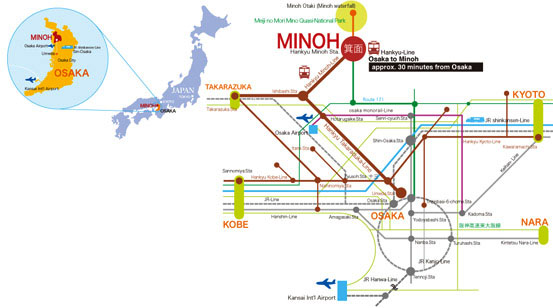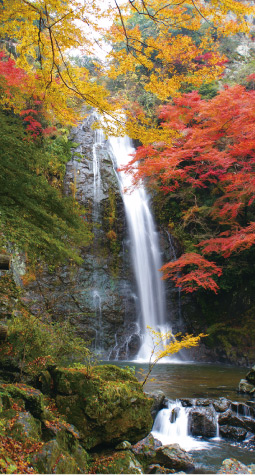Theme, Concept: “Fixed Gaze, Fostering Forms”. A unique form can be developed by the huge power generated from the connection of a viewer's gaze and an artist's intention. People's hands will help the artists spread their wings and update the memory, culture and history of Minoh with a new story. In 2015, the atmosphere along Takamichi will become enriched through the unification of artists, viewers, community and location. |
      △Minoh no mori Artwalk 2013 |
||||||||||||||||||||
About Minoh no Mori Artwalk Minoh is well known for the autumn leaves and the waterfall since long ago: it is the most popular tourist spot in the Hokusetsu region, where two million people visit throughout the year. The Takimichi, the venue of this art event, has a long, 1350 year history. It is said that Enno Gyoujya (a mountain priest) practiced asceticism at the waterfall in 658. Since then the Takimichi (a path to the waterfall) has not been a virgin forest. Its nature has been altered by human activities. That means that it is a nature loaded with cultural and historical meaning. It is very significant to install contemporary art work along the Takimichi, where a rich relationship between man and nature has developed, in both point of view, art, and sightseeing. These days, new sightseeing fields are created as a new tourism: eco tourism, green tourism, art tourism and so on. A common point among these new fields is to aim for the sightseeing eliciting a unique regional attraction which is a region-based relationship, interactive, and an exchange with locals. The state of the sightseeing industry is changing from putting the value on the beauty of landscape or scenery to putting the value on historical and cultural background which is sustainable sightseeing. This movement coincides with what we are trying to seek in art. The Takimichi, venue for this art event, is different from other recently held art events in various areas, sparsely populated locations or ecomonically depressed areas. Here, business has not declined at all, so it does not require revitalization. We would like to introduce the Meiji no Mori Quasi National Park to the visitors, not from a revitalization point of view, but from the artist's point of view. Their view contains not only the beauty of the Minoh landscape but also its history and culture through the art work. The exhibition space for artworks and performances are not arranged beforehand because the Takimichi, as a venue, is renowned for a sightseeing spot and a quasi national park. The artists themselves have to negotiate For this event, contemporary artists who are at the cutting edge, mainly in the Kansai area, are invited. Site-specific artwork is installed at stores and facilities along or neighboring the Takimichi, leading to the Otaki, or waterfall, from the Minoh station on the Hankyu railroad. Performances in the form of workshops, in the square in front of the Ryuanji-temple, will be featured. Site-specific art refers to an artwork that is created taking the location, the environment, the facilities, the culture, the history and the people's lives in this community into account. Communicating with locals to know their lives is intended for art tourists and other visitors to understand what contemporary art is and to appreciate it to rediscover Minoh's nature, history and culture with a new perspective provided by the works of art. Local awareness of these events builds and grows with each passing year, starting with the 2011, Minoh no Mori Artwalk, "A Point of Contact"and the 2013 Artwalk, "A Connected View Point" to this year's, 2015 theme, "Fixed Gaze, Fostering Forms". Toru Nakatani
|
|||||||||||||||||||||
Artist:
|
|||||||||||||||||||||
About the Space, Minoh Minoh is located in the corner of a mountain range in the Hokusetsu Province in Osaka. It is renowned for the Reijo (a sacred place: Saikoji, Ryuanji etc,) where Yamabushi (a Japanese mountain priest) practices asceticism. It also has a long history as a tourist attraction. In 1898, Mt. Minoh was designated as the first Municipal Natural Park. Resort ryokan (Japanese-style hotels), the Hashimototei opened in 1910. Many ryokans and tourist facilities have been built since then along the Takimichi and was designed as a tourist spot. Minoh was developed as a residential area by Minoh Arima Electric Railway (the current Hankyu Railroad). In the same year, the third zoo in Japan was opened by the Takimichi. In 1967, both Mt. Takao in Tokyo and Mt. Minoh were designated as the Meiji no Mori Quasi- national Park as a Meiji 100th anniversary memorial project. Minoh, in spite of a long history as Reijyo, a sacred place, and a sightseeing spot, is a rare place where nature is well-preserved. You will be able to come across a waterfall, a mountain stream and a forest in a 30 minute ride by train from Umeda in downtown, which is one of the main business districts in Osaka. It is a rare spot even among tourist sites in Japan, where instantly the urban hustle and bustle can slip from your mind. Minoh has even been selected one of the 100 Forests in Japan for Shinrin-yoku, or forest bathing, a practice of walking in nature for its therapeutic benefits. Mt.Minoh is also famous as one of Japan's three biggest insect habitats (the other two being Kifune in Kyoto and Takao in Tokyo) for its vast vegetation of about 1300 species that can be used as food supplies for about 3500 species of insects. It is only three kilometers distance from the Minoh station on the Hankyu railroad to the Otaki (waterfall). Once you step in the Takimichi, you experience a cool breeze with sounds of a mountain stream and forest scent blowing across your cheek. You sense phytoncides (naturally occurring compounds produced by plants to protect themselves from disease) emanating from the woods and negative ions emitting from the mountain stream. The Takimichi refreshes and soothes our body and mind. In spring, the green of the woods heals tired eyes. In autumn, scarlet tinged maple leaves please the eyes of visitors. The nature of Minoh is friendly to the five senses and brings us blessings. The nature of Minoh is warm since it has been living together for long time with humanity. Its culture and history, which have been built up together with people, exist there. On the Takimichi, although it is not a virgin forest anymore, stories remain, passed on for 1350 years from generation to generation. The Minoh no Mori Artwalk 2015, being in symbiosis with nature, spins a new yarn.
|
   |
Access: |

|
|
|
Space:
|
 △Minoh Otaki (Minoh waterfall) |
|||||||||||||
Organizers: Executive Committee of the Minoh no Mori Artwalk 2015 |
 △Minoh no mori Artwalk 2013  △Contemporary Art Gallery Zone |
|||||||||||||
About Zone, Our Contemporary Art Gallery Zone In December 2008, the Contemporary Art Gallery Zone opened at the Sakurai Ichiba (marketplace in Sakurai) Minoh Osaka, Japan. Since then, Zone has become famous among the people in this community as the gallery that has provided them an opportunity to see contemporary art. The reason we opened the gallery in the marketplace is because we want people in this community to be aware of how interesting and accessible contemporary art is, even for people not interested in art. We would like to inform people on what we think contemporary art is through our exhibitions. The Zone gallery, has no walls, figurative or literal, existing between public walkways and the interior of this setting, so pedestrians can freely stop by with shopping bag in hand to join in with full of curiosity, and have fun. Everyday life space becomes art space. Art space becomes everyday life space. There are no boundaries between life and art. We would like you to feel closer to contemporary art in such a space and to introduce the works which meet our esthetic without the limitation of the genre of art: installation art, performance art, painting, drawing, sculpture and others. Our gallery's year-round programming features solo and group exhibitions by regional, national and international visual artists. The gallery also promotes a range of programming including artist talks, openings, lectures and other special events. Gallery programming aims to foster professionalism and appreciation of regional visual arts practice, and provides the community with exposure and access to a diverse range of contemporary visual arts practices and theories. We have created an art space with this new concept. |